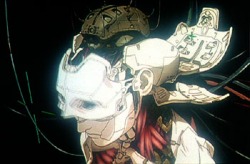

Molly from Gibson's Neuromancer and Motoko, aka the major, from, Ghost In a Shell play very similar roles in each of their stories. Molly is a tough chick, with a semi sensitive interior, she has all the latest gadjets, as Lyla Fujiwara argues in Twofaced Technology, and she is one hot chick. All of these characteristics pertain to Motoko as well. Though these two leading ladies have a lot in common there are some major differences.

The biggest difference between the two is what they are both looking for in the stories. Molly has moved her tear ducts to her throat so she can spit instead of cry. It is almost as though she is trying to turn herself into some emotionless machine. Molly has all of the latest technological advancements and she has received them by selling herself, again in a more emotional way she is dehumanizing herself. The escape to machine is a great attraction to Molly.
Though Motoko is hardly even human anymore her concern for having a Ghost is huge. The definition of a Ghost is further explained in Alexander Rosenthal's essay, The Tranmigration of Ghosts. She risks her life to get inside the puppet master to compare her self to the puppet master. She often talks about her fear of not really have a ghost, but really being all machine. The thought of the loss of her soul and emotions almost literally destroys her.
They are tough strong and good looking, but in the end very different characters from one another. One is escaping the reality of what it is to be human, and one is desperately grasping on to her soul. Some argue that this difference is what makes eastern and western culture different, but perhaps they are just two different ways of presenting a dystopian future; one by letting you see a human become machine and like it, and the other by someone who can hardly tell who she is anymore. Both characters create an eerie representation of the future, but at least I won't have to worry about bad knees.

Last modified 31 October 2006